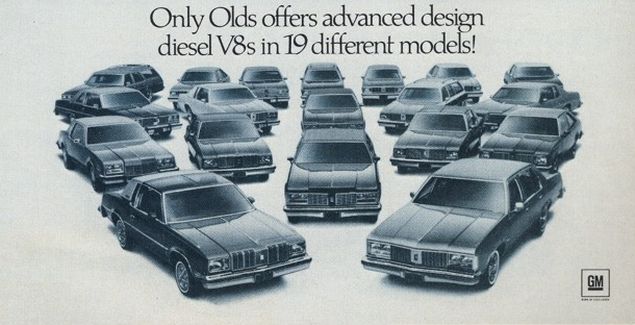Remember when Oldsmobile embraced the diesel engine?
Posted on Nov 16, 2013 in Featured | 4 comments

The 1979 Oldsmobile diesel range.
As the 1970s came to a close, automakers were faced with ever-stricter emission regulations on gasoline engines. Thinking outside the box, GM tasked its Oldsmobile division with creating a range of diesel engines that would be immune from gasoline emission standards, while delivering the performance and fuel economy that consumers wanted. On paper, it seemed brilliant; in execution, however, it was anything but.
The first Oldsmobile diesels arrived for the 1978 model year, and they carried a modified version of the brand’s 5.7-liter (350-cu.in.) V-8. By 1979, the year of this magazine ad, the division had increased its oil-burning options to include the 4.3-liter (261-cu.in.) V-8 as well, offering diesel engines in a whopping 19 Oldsmobile models. With the promise of up to 32 MPG from diesel Cutlass models and up to 28 MPG from the diesel-powered Cutlass Cruiser station wagon, Oldsmobile seemed as if it had the answer to consumers’ needs, but trouble was brewing.

While Oldsmobile reinforced the 350 V-8 block for diesel duty and created new heads, it retained the same head bolt pattern as used in its gasoline engines. Since diesel engines require higher compression, head bolt stretching (or outright failure) became a problem with the 5.7-liter diesel engine. This led to coolant leakage in the cylinders, frequently ending with a hydrolocked engine and catastrophic internal damage.
The diesel fuel system design used by Oldsmobile also failed to include a water separator, reportedly for cost-cutting measures. Diesel fuel of the day frequently contained water, which led to fuel system corrosion and injection pump failures on the Oldsmobile models, further worsening their already bad reputation. In 1982, the division introduced a 4.3-liter diesel V-6 that was greatly improved, but the fix proved to be too little, too late.
Had GM and Oldsmobile put more time into the development of diesel engine offerings, there’s still no guarantee the experiment would have been a success. Even by the relaxed expectations of the day, the cars were almost terrifyingly slow, and their soot-belching and frame-shaking manner weren’t what consumers expected from a near-luxury domestic car. In late 1984, Oldsmobile pulled the plug on its diesel experiment, but not before launching class action lawsuits, establishing lemon laws from coast to coast and tarnishing the reputation of diesel engines, perhaps forever, in the eyes of U.S. car buyers.





Knew a guy who drove a Chevette diesel. A rare car he drove it for years without much trouble. In fact you never see Chevettes on the road anymore. I had a 77 kind of a throw away car.
I drove a ’76 Chevette with no options for a year or so. Bright yellow. I really miss that car.
I worked at a Jobber later 80’s that also had a machine shop and did engine swaps–believe it or not they did a lot of diesel to gas engine swaps so much that good used Olds 350s and 307s were expensive at the wrecking yards.
I was thinking about the water in fuel problem and unlike big rig trucks a lot of Olds may have been garage kept in the winter–as the car would warm up after being outside water can condense inside the tank–my Uncle pointed this out to me on his big rig that had been brought into a repair garage for a few hours.
I used to work with a young man that had done the swap to gas as the coal burner had given up. I bought a diesel Tempo back in the day and the owner said it was blown up. I had it pull started down the road,drove it a little bit and then discovered the gaping hole behind the starter. so I found a diesel escort and did the swap and decided that I didn’t like fueling that car at the station so I sold it. bad enough that I sometimes have to fuel my D6 cat.